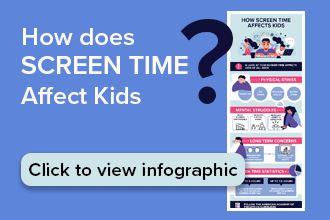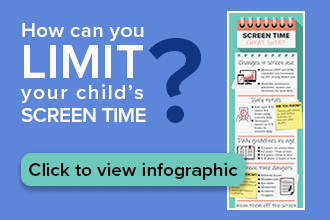Advantages of a 24-hour digital detox for kids

Give their young eyes a break
Spending a day away from technology can be a hurdle for anyone in this day and age. Many children rely on digital devices for entertainment as well as education. But screens can also take a toll on their vision and overall development — so the occasional “digital detox” is definitely a good idea.
Disadvantages of too much digital screen use
Why challenge your child to a day without screens? Although they may find great amusement and even learn through digital programming, excessive screen use can also be harmful.

Experts advise that fine motor and communication skills can be affected by too much screen time. More specifically, it can affect things like:
Writing, coloring and other motor skills
Eye contact and socializing
Creative and cognitive competencies
Looking at screens for extended periods of time can also harm your child’s eyes. Some kids may experience digital eye strain, dry eyes and other irritations. Recent studies have also revealed that screen time may put your child at risk for developing myopia (nearsightedness).
SEE RELATED: How to limit your kid’s screen time
Screen time may contribute to myopia
According to recent studies, spending too much time looking at screens may significantly affect the eyesight of children and young people. Specifically, the risk for myopia seems to be greater with excessive screen use.
Some research suggests that the risk of myopia increases by 30% for those who use smartphones or other similar digital devices consistently. This risk can be as substantial as 80% if that is combined with extensive use of computers.
Not only is the risk of myopia heightened with screen use, but the severity of myopia is also a concern.
With so much at stake for your child’s eyesight, avoiding digital screens — even if it’s just for one day — can help put things into perspective.
SEE RELATED: Can reduced screen time cure or reduce myopia?
How to get your kids to put the screen away
The World Health Organization (WHO) recommends 60 or fewer minutes of screen time per day for 3- to 4-year-olds. For children 1 and younger, no screen time is recommended at all.
Of course, limiting screen use is beneficial for kids of all ages. So how can you get your child to put down the tablet, log off the computer or turn off the TV?
Kids love watching videos and interacting with online content. But they also love a good challenge. Getting them to stay away from screens for 24 hours may seem difficult, but it can be fun and rewarding.
SEE RELATED: Screen time recommendations by age
Try these 20 screen-free activities
There are countless ways to enjoy time without technology, from reading a book to making up a cool new dance. Consider, it wasn’t all that long ago that screens weren’t remotely a part of daily life.
The following 20 alternatives to screen time can help you get the ball rolling for your child’s digital detox. Note: Your child may need supervision for some of these activities.
Read a book (or read to your child if they are a youngster)
Play games or sports outdoors
Play a board game or put together a puzzle
Do some arts and crafts
Color in a coloring book
Write a letter to a loved one
Draw on pavement or on your fence with sidewalk chalk
Play at a nearby park
Take your bike for a ride
Go for a swim
Bake a delicious treat
Conduct an age-appropriate science experiment
Go to the library
Have a dance party
Play dress-up
Play hide and seek
Build a pillow fort
Play card games
Have a picnic in the backyard
Cut out pictures in magazines and use them to make a collage
Although many of these won’t take up an entire day, incorporating them into your child’s routine is sure to get them away from the screen. Combine a few of your child’s favorites (or come up with your own) for a day of old-fashioned, screen-free fun.
Have your child invite a friend or sibling to play with them if they like. Better yet? Challenge your child to come up with even more ways to play and explore without using a screen.
Consider a reward system for avoiding screens
Still not convincing your kid? A little incentive could help! Offer your child a reward for completing their 24-hour digital screen detox.
Consider the efforts of Reviews.org, which offered select people more than $2,000 for putting their phone away for a whole day.
Of course, you don’t need to offer your child that big an incentive. Something like a visit to the toy store or a trip to the zoo may be more the right speed.
Outdoor play may also help prevent myopia
Each activity listed can be fun for your child. But the outdoor activities may actually be even more valuable. Why is this?
Studies have shown that spending more time in sunlight can actually help prevent or slow the progression of myopia in children. The natural outdoor lighting promotes eye development — plus, playing outdoors is good for children in many other ways as well.
Just remember to protect your little one’s eyes from UV exposure with a fun pair of kids sunglasses.
SEE RELATED: Can you prevent myopia?
Reflecting on the no-screen challenge
After the challenge is completed, review and reflect with your child about what they enjoyed during their 24-hour screen-free adventure. What was the best part? What did they learn? Would they do it again?
Next, educate your child about screen time and their eyes. Let your child know that by stepping away from the screen, they gave their eyes a nice break from all the bright artificial light. They also gave their brain a little mental vacation.
Encouraging your child to play outdoors and participate in activities outside the world of technology can help them ease out of their screen-time habits. In the long run, this can help with their vision, development and even creativity.
Putting down the screen isn’t all you can do to support your child’s visual development. Be sure to stay up-to-date with routine pediatric vision appointments. In the meantime, get your child pumped up for their next screen-free challenge!
READ MORE: How screens affect kids’ eyes and what you can do about it
New WHO guidance: Very limited daily screen time recommended for children under 5. American Optometric Association. May 2019.
Guidelines on physical activity, sedentary behavior and sleep for children under 5 years of age. World Health Organization. April 2019.
Myopia prevention and outdoor light intensity in a school-based cluster randomized trial. Ophthalmology, the journal of the American Academy of Ophthalmology. January 2018.
How too much screen time affects kids' eyes. Children’s Hospital of Philadelphia. December 2018.
Screen time linked to risk of myopia in young people. ScienceDaily. October 2021.
Association between digital smart device use and myopia: a systematic review and meta-analysis. The Lancet: Digital Health. October 2021.
Page published on Wednesday, December 8, 2021






